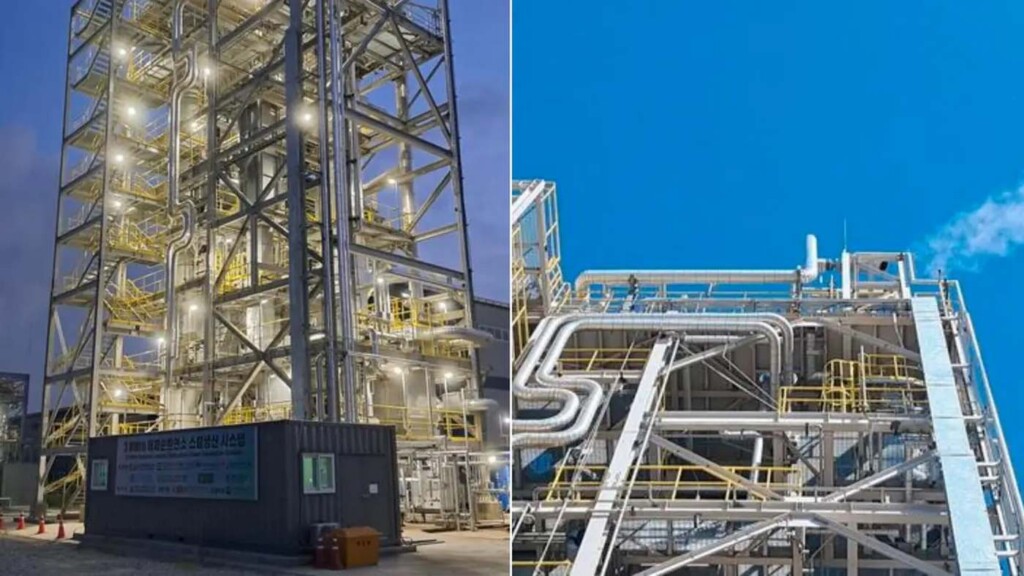 The CLC demonstration plant developed by the research team – credit, Korea Institute of Energy Research
The CLC demonstration plant developed by the research team – credit, Korea Institute of Energy ResearchAfter 300 hours of continuous operations, a 3 megawatt demonstration power plant in South Korea has offered a glimpse into the future of natural gas burning.
Utilizing technology that offers the potential for natural gas plants to capture an additional 150,000 metric tons of CO2 every year, the demonstration has achieved never-before-seen results in controlling what comes out of the smokestack.
Hundreds of years ago, industrialized nations switched from burning wood or dung for power to coal. Coal was followed by oil, and oil by natural gas—all three of which are known as fossil fuels. Today, just below a quarter of all power generation is attributed to natural gas.
In terms of emissions, natural gas is by some distance the superior of the three, but it still releases billions of tons of CO2 into the atmosphere every year. Compared to coal and oil, the nature of natural gas combustion allows for better opportunities to “capture” CO2 released from the process.
However, along with being expensive, analysis has shown that often the captured carbon is used to squeeze more fossil fuels out of declining wells.
Now however, the Korea Institute of Energy Research (KIER) has successfully demonstrated the world’s largest gas power generation technology capable of inherently separating carbon dioxide from nitrogen, a method called chemical looping combustion (CLC).
In conventional gas power generation, fuel combustion releases CO2 alongside nitrogen and water vapor. Once emitted, CO2 mixes with nitrogen in the air, necessitating specialized facilities to selectively separate and capture pure CO2 for storage. This additional process increases power generation costs.
To tackle this challenge, CLC technology is emerging as an eco-friendly power generation solution. CLC technology delivers pure oxygen to the fuel using specialized oxygen-carrying particles. These particles release oxygen during combustion and later reabsorb it when exposed to air, continuously repeating the cycle to sustain the process continually and eliminating any reaction with nitrogen that would have to be undone later.
As a result, the combustion process generates carbon dioxide and water vapor, enabling direct capture of CO2 without the need for additional separation, an innovation that would shave 30% off the cost of running a gas power plant that captures the CO2 it generates.
Additionally, unlike conventional combustion, which produces nitrogen oxides, a major contributor to ultrafine particulate matter and the health impacts it brings in urban environments, this technology operates through flameless combustion, drastically reducing NOX emissions.
In 2023, KIER and its partners established a 3 MW-scale pilot plant, the largest of its kind globally, and conducted full-scale demonstration tests. Over 300 hours of continuous operation, the technology achieved a carbon dioxide separation and emissions efficiency exceeding 96%, surpassing the previous global benchmark.
Another benefit of CLC technology is that when done right, it generates steam from the water vapor that can directly contribute to power generation. Though tested in Europe, the United States, and China, no CLC demonstration has ever achieved steam production.
KIER, however, did.
If the demonstration scale of the CLC technology is small, efficiency is high, but heat loss is significant, making it impossible to generate steam. Similarly, if efficiency cannot be maintained while scaling up, steam production does not occur.
KOREAN EXCELLENCE: The World’s Highest Spokeless Ferris Wheel Set for Construction
KIER successfully scaled every aspect of the demonstration plant to a point at which steam production was achieved, a world first.
According to a statement from KIER, economic analysis of CLC technology predicts that, compared to a conventional 100MW natural gas power plant, it will generate an additional annual operating profit of $10.1 million and generate 4% more power.
STORIES FROM THE ENERGY MARKET: Ferries, Planes Line up to Purchase ‘Solar Diesel’ a Cutting-Edge Low-Carbon Fuel from Swiss Start-up
CO2 capture costs would be reduced by 30% compared to existing methods, enabling the capture of over 150,000 tons of CO2 per year. This advancement is expected to make a significant contribution to achieving national carbon neutrality goals.
“To achieve national carbon neutrality, it is essential to establish and operate gas power plants that incorporate innovative technologies such as chemical looping combustion (CLC),” said Dr. Ryu Ho-jung, the lead researcher of the CCS Research Department.
MORE STORIES LIKE THIS: Old Coal-Fired Power Plant Found the Key to Solving America’s Biggest Clean Energy Challenge
“We will continue to advance and demonstrate our technology to accelerate the commercialization of next-generation power generation solutions.”
Though many climate activists will feel that money and minds should be bent on removing natural gas from use rather than improving its efficiency, many nations will simply not do this. Invented in the late 20th century, coal scrubbers significantly reduced the health effects of coal burning in built-up areas, and today, it’s only just being phased out of use in the West. If widely implemented, CLC technology could be reducing the impact of human power generation on the atmosphere for 40 or 50 years in advance of their hypothetically ultimate retirement.
SHARE This Groundbreaking Improvement In Natural Gas Use With Your Friends…
Source link

